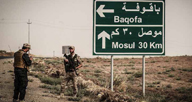The ISIS Threat in Perspective

 This coalition of the willing will score some short-term victories, but should brace for longer-term pain
This coalition of the willing will score some short-term victories, but should brace for longer-term pain
A coalition of over 50 countries is now on the front lines fighting ISIS/ISIL – the Islamic State of Iraq and Syria, or the Islamic State of Iraq and the Levant. Unlike the post-9/11 ‘coalition of the willing,’ this assembly of states appears to be more wide-ranging, and its combined firepower could prove overwhelming – at least in the short term – for ISIS. The fact that Washington is leading the initiative to engage multilaterally against ISIS has arguably enhanced the immediate punch of the fight. And with a number of Arab countries, and now Turkey, directly contributing to the military strikes the mission against ISIS is increasingly seen as legitimate from the perspective of the Muslim world.
The 2006 proclamation, posted on the jihadi website Tajdeed.org, of the establishment of the Islamic State of Iraq (ISI), was a clear consequence of the 2003 US invasion of Iraq, the subsequent establishment of a Shia-led government in Baghdad, and also the growing prominence of the Kurds – dynamics that disenfranchised the Sunni elites that had ruled Iraq under Saddam Hussein. ISI said as much in its very first statement, in which it emphasized that its project was a response to the division of the country among the Shia and the Kurds. At the time, the group had limited objectives – principally to establish its control over an area encompassing “Baghdad, Al Anbar, Diyala, Kirkuk, Saladin, Ninawa, and parts of the provinces of Babel and Wasit,” for what it claimed to be the peace and safety of the “Mujahideen, the Ulama of Iraq, the chiefs of tribes, and the Sunnis in Iraq.”
Despite skepticism among fellow Sunnis about the feasibility of creating an Islamic state, ISI managed to bring a number of groups together. It had to deal with severe opposition – notably from Al Qaeda Central (AQC), then led by Osama bin Laden – which opposed ISI’s extreme brutality. Ultimately, AQC publicly disassociated itself from ISI.
What explains the metastasis of this group from a putative “JV team” to a threat of apparent strategic proportions, possessing territory in both Iraq and Syria, recruiting cadres from all over the world, and amassing huge assets to finance and sustain its ambitious caliphate project? While ISIS capitalized on the discontent caused by the divisive policies of former Iraqi prime minister Nouri al-Maliki, its surging strength can be attributed to the fallout from the Arab Spring which, as the current Al Qaeda leader Ayman al-Zawahiri has emphasized, provided opportunities to undertake jihadist state-building initiatives across the region. As Middle Eastern governments and their security and intelligence apparatus remained preoccupied with internal protests and uprisings, groups that were largely marginal or marginalized were suddenly able to revive. Erosion of state power linked to the inexperience of the new regimes and the emergence of ungoverned or poorly controlled territories created spaces for various jihadists to regroup, reorganize and train. Prolonged instability, unmet promises of reform, and more general economic woes exacerbated public frustration and increased the susceptibility to radicalization. All of this the jihadists exploited.
The rise of ISIS is also attributable to the huge amount of money – estimated to be between US$800 million and $1 billion per year – that the group collects from multiple sources, including looting, donations, and revenues from captured oil and gas fields. For good measure, the group also appropriated the military hardware of the collapsing Iraqi army in the immediate aftermath of the pullout of US forces from Iraq.
ISIS’s spread also stems from its ability to harness the media, including social media, with which it has, according to Shiraz Maher of the International Centre for the Study of Radicalisation at King’s College London, “created a brand, spread a seductive narrative and employed powerful iconography,” thereby effectively becoming a magnet for foreign fighters – including, of course, fighters from North America and Europe.
Most assessments characterize ISIS as significantly different from Al Qaeda specifically in that it controls territory. However, in the post-9/11 context, territorial possession or mere presence at an identifiable physical location has proven to be a serious vulnerability, as with Al Qaeda in Afghanistan and the Liberation Tigers of Tamil Eelam (LTTE) in Sri Lanka. While Al Qaeda enjoyed a measure of stability in the areas in which it set up its training camps and safe havens – giving it the luxury of time and space to plan and carry out multiple operations and build up a worldwide movement – the same cannot be said about ISIS. Indeed, ISIS has been in a constant fight to retain and not be ousted from the areas that it has controlled. This will doubtless continue to be a huge, and possibly growing, cost to the group, involving money and other resources, and eroding the group’s capacity to properly establish the governing structures and norms necessary for statehood. In this sense, failure to credibly demonstrate the attributes of a functioning state would undermine its message – a message that, as mentioned, has been attracting recruits for the group from around the world – and could severely dent its ambitious caliphate project.
To be sure, if terrorism, as a tactic, is meant to create fear and intimidation in the wider society, then ISIS appears to be scoring some successes. With beheadings and well-crafted missives accompanying these beheadings, ISIS has arguably provoked the same kind of fear and reaction that Al Qaeda did with the 9/11 attacks. The potentiality of foreign ISIS recruits returning to North America and Europe to carry out attacks in their respective homelands – a potentiality still unsubstantiated – has only added to public anxiety. For context, we should also note the speculation that ISIS could launch attacks through the under-protected US-Mexico border and target the power grid in the US; the elevation of the risk of an imminent terrorist attack to “severe” by the British; the recent ISIS-related arrests in Australia; and also the beheading of a French national by a group supporting ISIS. All of these events and episodes have further intensified the overall fear factor in respect of ISIS.
It is worth recalling, of course, that until ISIS had begun to appropriate territory and establish some rudimentary state control – especially in strategic areas with oil and gas fields and water resources – or to demonstrate barbarism (even bordering on genocide), there had been almost no serious discussion of the group in the countries that are now attempting to contain it. Now the debate is about whether the threat from ISIS is more relevant for the US or instead for other countries – specifically in Europe and the Middle East.
And yet country-specific calculations might not be sufficient to give us granularity in respect of the specific contours of the ISIS threat. First, the number of foreign citizens fighting for ISIS remains unclear. Second, the underlying motivation of these individuals is understudied. Fighting in Syria, for instance, should not lead one to the conclusion that, upon their return, these jihadists would necessarily carry out attacks in their home countries. Other things being equal, much would seem to depend on the extent of the radicalization of the concerned individuals and, more importantly, the type of narrative that radicalized them in the first place.
There could be different outcomes if radicalization is based on a purely religious narrative – that is, fighting for a religion that is perceived to be under threat or otherwise helping in the establishment of an Islamic state – as compared with radicalization based on perceptions of social, economic or political exclusion in particular countries. In the latter case, desires to carry out attacks to avenge domestic grievances or wrongs could well be stronger. This makes it imperative to investigate the roots of radicalization in country-specific contexts.
Ultimately, success against ISIS will depend on how the fight is conducted. Military strikes alone may win the day for the US-led coalition in the coming months, but defeating ISIS or ISIS-like groups will surely require countering their ideology and restricting their ability to amass resources (human, money and materiel). In other words, the kinetic aspects of counterterrorism – including air strikes or targeted killings – may lose their relevance as soon as the threat appears to be losing its steam, while the impact of counter-ideology and counter-financing measures can be long-term and sustaining. In this respect, the unanimous resolution of the UN Security Council on September 24th urging member states to take measures to suppress the recruiting, organizing, transporting, equipping and financing of ISIS is significant. The religious narratives of the group are also being challenged by mainstream Muslim communities in countries around the world, just as some of the most prominent Muslim countries begin to fight ISIS with their own military assets.
At the same time, with its brutality and its failure to discriminate between even attacks on Muslims and those against non-Muslims, ISIS could be sowing the seeds of its own eventual downfall. The brutality, broadcast all over the world, might earn the group short-term gains – winning a recruit or two, and otherwise terrifying many people, Muslim and non-Muslim alike, around the world. But such extremes have proven to be counterproductive for the overall jihadist movement in the past, as evidenced by documents recovered from Osama bin Laden’s hideout and the writings of other prominent leaders of the movement. So too may they prove to be counterproductive before long for ISIS.
Indeed, despite the expansionist rhetoric of ISIS and the attempts by the West to generalize the sense of the threat posed by the group, the ISIS agenda will likely remain local or at best regional. Suggestions to the effect that the world is at ‘war’ with ISIS point to disproportionality (and even hysteria) in the international response. But without a longer-term counter-ideological campaign, and indeed without boots on the ground, there may not be meaningful, strategic degradation of ISIS. Instead, the victories won by the coalition of the willing will be short-term, rather than world-historical. The pain may come later.
Arabinda Acharya teaches at the Joint Special Operations Master of Arts Program of the National Defense University at Fort Bragg, North Carolina. Dharitri Dwivedy is a PhD student at the Madras Christian College, University of Madras, India. The views expressed in this article are solely those of the authors.
(Photograph: The Canadian Press / AP / Gail Orenstein)









